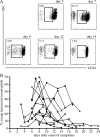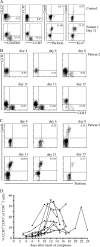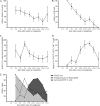A systemic neutrophil response precedes robust CD8(+) T-cell activation during natural respiratory syncytial virus infection in infants
- PMID: 20015982
- PMCID: PMC2820924
- DOI: 10.1128/JVI.01807-09
A systemic neutrophil response precedes robust CD8(+) T-cell activation during natural respiratory syncytial virus infection in infants
Abstract
Severe primary respiratory syncytial virus (RSV) infections are characterized by bronchiolitis accompanied by wheezing. Controversy exists as to whether infants suffer from virus-induced lung pathology or from excessive immune responses. Furthermore, detailed knowledge about the development of primary T-cell responses to viral infections in infants is lacking. We studied the dynamics of innate neutrophil and adaptive T-cell responses in peripheral blood in relation to the viral load and parameters of disease in infants admitted to the intensive care unit with severe RSV infection. Analysis of primary T-cell responses showed substantial CD8(+) T-cell activation, which peaked during convalescence. A strong neutrophil response, characterized by mobilization of bone marrow-derived neutrophil precursors, preceded the peak in T-cell activation. The kinetics of this neutrophil response followed the peak of clinical symptoms and the viral load with a 2- to 3-day delay. From the sequence of events, we conclude that CD8(+) T-cell responses, initiated during primary RSV infections, are unlikely to contribute to disease when it is most severe. The mobilization of precursor neutrophils might reflect the strong neutrophil influx into the airways, which is a characteristic feature during RSV infections and might be an integral pathogenic process in the disease.
Figures






References
-
- Adkins, B., C. Leclerc, and S. Marshall-Clarke. 2004. Neonatal adaptive immunity comes of age. Nat. Rev. Immunol. 4:553. - PubMed
-
- Barrios, C., P. Brawand, M. Berney, C. Brandt, P. H. Lambert, and C. A. Siegrist. 1996. Neonatal and early life immune responses to various forms of vaccine antigens qualitatively differ from adult responses: predominance of a Th2-biased pattern which persists after adult boosting. Eur. J. Immunol. 26:1489. - PubMed
-
- Blom, D., M. Ermers, L. Bont, W. M. Van Aalderen, and J. B. van Woensel. 2007. Inhaled corticosteroids during acute bronchiolitis in the prevention of post-bronchiolitic wheezing. Cochrane. Database. Syst. Rev. CD004881. - PubMed
-
- Bont, L., C. J. Heijnen, A. Kavelaars, W. M. Van Aalderen, F. Brus, J. T. Draaisma, S. M. Geelen, H. J. van Vught, and J. L. Kimpen. 1999. Peripheral blood cytokine responses and disease severity in respiratory syncytial virus bronchiolitis. Eur. Respir. J. 14:144. - PubMed
-
- Bont, L., A. Kavelaars, C. J. Heijnen, A. J. van Vught, and J. L. Kimpen. 2000. Monocyte interleukin-12 production is inversely related to duration of respiratory failure in respiratory syncytial virus bronchiolitis. J. Infect. Dis. 181:1772. - PubMed
Publication types
MeSH terms
Substances
LinkOut - more resources
Full Text Sources
Other Literature Sources
Medical
Research Materials

